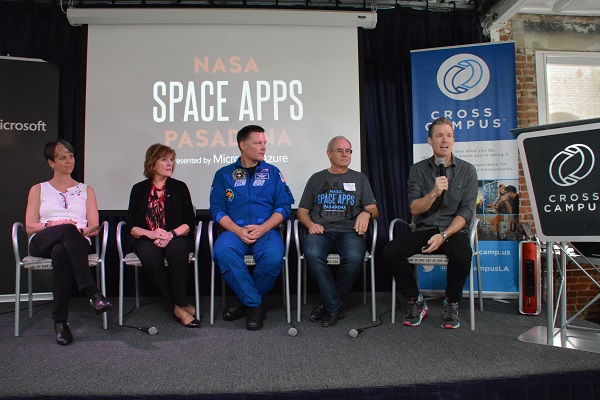by Dot Cannon
“I’m absolutely amazed at the products that can come out in two days. Y’all are awesome,” said NASA Deputy Chief Scientist Gale Allen.
Saturday morning, April 23rd, had arrived. Day 1 of NASA’s 2016 International Space Apps Challenge was getting started at the Space Apps Pasadena location: Pasadena’s Cross Campus facility. Four NASA guests were seated onstage for opening comments.
Throughout the day, these NASA staff members would be assisting teams with their projects. Some of them would also act as judges for Sunday’s competition.

“You’re not following history, you’re making history,” said Jet Propulsion Laboratory IT Chief Technology Officer Tom Soderstrom. “You are citizen scientists.”
For the next twenty-four hours or so, the gathered audience would work together–with strangers, friends and family members–to create something really exciting.

NASA’s Space Apps Challenge, now in its fifth year, is a free event. This is a hack-a-thon at its best–with some important differences.
Participants are asked, in Space Apps’ Code of Conduct, to “
“Five years ago, we had to convince the White House, and lots of the federal government agencies, that you can hack for (social) good,” said Deborah Diaz, NASA Chief Technology Officer for IT. “It’s bringing (in) not just the technical individuals. It’s people with fashion degrees working on sensors and wearables. It’s families that are maybe looking at 3D printing for the first time and thinking of possibilities.”
On Friday, the second annual Women’s Data Boot Camp had welcomed a full-to-capacity crowd. Hands-on demonstrations gave guests the opportunity to get comfortable with scientific principles. The demonstrations also took a lot of the “intimidation” factor away, for new attendees. The day had concluded with guests choosing one of ten projects on which they would like to collaborate, as team members.

NASA Space Apps Pasadena organizer Joe Brisbois went over the weekend’s schedule and requirements.
For NASA’s 2016 International Space Apps Challenge, participants could use data from NASA’s data portal to create their hack. Microsoft had provided free credits for their Azure cloud service platform, while Intel® had made Edison boards and Grove starter kits available for use in team projects.
And there were prizes to be won. On Sunday, the judges would choose a first- and second-place winner for the best projects. There would also be a People’s Choice winner, as well as winners for the best use of Azure, Intel hardware and Socrata data.

“Have a wonderful day, kick some butt and let’s have fun,” said Joe.
That’s exactly what happened.


Our particular team, Boom Clap, worked together to create a computer application that would educate the public on sonic booms.

Among Boom Clap’s group members: a professional coder, at least three students and a STEM educator.

Periods of concentration-laden silences were broken up by consultations. Teams had the opportunity to get input from onsite tech entrepreneurs and the visiting NASA staff…

 …including astronaut Doug Wheelock.
…including astronaut Doug Wheelock.
Creating code, researching, finding images, writing a script and getting it all to work together were the tasks at hand. And the clock was ticking.

At the time this reporter came on board, the Boom Clap team–and everyone else collaborating on 2016 Space Apps Challenge Pasadena–had less than twenty-four hours to create their projects.

Members of some teams participated virtually. Others would stay till midnight.

But everyone was counting down to one o’clock on Sunday, when all the teams would present their work. And Sunday afternoon would end with the judges’ decisions, on the best innovations of 2016 International Space Apps Challenge, Pasadena edition.
This is Part Two of a three-part series.

